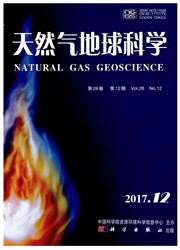

 中文摘要:
中文摘要:
利用测井、岩心、薄片及孔渗数据,对库车前陆冲断带白垩系巴什基奇克组砂岩储层特征进行垂向对比分析发现,由上到下,储层物性显著变差。通过分析构造应力与成岩作用及储层物性之间的关系表明,构造挤压作用下,地层褶皱变形,由上到下,从局部张应力过渡为压扭应力,应力值逐渐增大;上部发育张裂缝,裂缝数量多、开度大,下部发育剪裂缝,裂缝数量少、开度小;受构造应力与裂缝影响,由上到下,储层压实增强,压实减孔量相差2%~3%,溶蚀变弱,溶蚀增孔量相差1%~2%,从而造成储层物性垂向分异。因此,储层垂向差异分布受构造挤压显著控制。认识构造挤压对储层垂向分布的控制,对深入理解成岩控制因素及预测挤压型盆地有利储层发育层段均具有重要意义。
 英文摘要:
英文摘要:
Various data including well logging,cores,thin sections,porosity and permeability were used to analyze the vertical variation of Bashijiqike sandstone reservoir in Kuqa foreland thrust belt.The Bashijiqike reservoir property becomes obviously worse from up to down.The relationship between tectonic stress,diagenesis,and pore development showed,the local tensile stress turned into torsional stress and the tectonic stress size gradually increased from up to down under the tectonic compression.Tension fissures with large fracture opening width are developed,whereas,fracture number decreases and shear fissures with small fracture opening width relatively increase down to the lower Bashijiqike Formation.Compaction enhances and dissolution decreases with the increase of tectonic stress size and development of fewer fractures,the reduced porosity by compaction and enhanced porosity by dissolution are approximately 2%-3% and 1%-2% respectively.So,the vertical difference is primarily determined by tectonic compression.The results help to further understand the diagenesis,and predict favorable reservoir distribution in compressional basins.
 同期刊论文项目
同期刊论文项目
 同项目期刊论文
同项目期刊论文
 期刊信息
期刊信息
